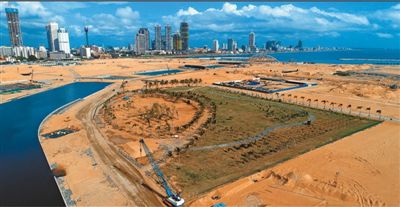China and Sri Lanka are steadily advancing the joint construction of the Belt and Road project “A new chapter in cooperative development”
Recently, projects undertaken by Chinese companies in Sri Lanka, such as the Central Sri Lanka Expressway Project, the Kang Water Supply Project, the Karugango to Molaghakanda Connection Channel Project, Colombo Water Supply Pipeline Network Transformation, Colombo Port City and other projects undertaken by Chinese companies in Sri Lanka have resumed work and production. The local economy resumed development.
“Guarantee project advances as planned”
Kandy is a famous tourist city in central Sri Lanka. The six administrative areas in northern Kandy have been short of water for a long time, and it has been the desire of local people for many years to use clean water. Recently, the pipeline laying construction of the Kang Water Supply Project undertaken by Sinohydro officially started. The construction area of the project covers approximately 318 square kilometers. After completion, it can meet the daily water consumption of 470,000 people. It is the largest municipal water supply project currently under construction in Sri Lanka and is financed by the Export-Import Bank of China.
Midawat, the director of the Kang Water Supply Project, said that with the joint efforts of both parties, the project strictly implemented epidemic prevention measures and accelerated the resumption of work and production. Midawat said: “Thank you for the important support from China, especially the Chinese employees sticking to their posts, overcoming difficulties, and ensuring that the project proceeds as planned.”
At the site of the first tender section of the Sri Lanka Central Expressway undertaken by China Metallurgical Corporation, a wide roadbed extends far away in the shadow of the coconut grove. The project is 36.59 kilometers long and connects the capital Colombo and Kandy. After completion, it will realize the interconnection with the airport expressway, the Colombo outer ring expressway, and the southern expressway. The construction of the project has created approximately 1,500 local jobs. After opening to traffic, it will further promote the development of the surrounding economy.
Sri Lanka’s “Daily Mirror” recently reported that after the completion of the Central Expressway built by Chinese companies, the journey from Cong Kang to Colombo will be shortened to less than two hours.
“The city of the future is rising”
The Colombo Port City project is one of the landmark projects of the “Belt and Road” construction between China and Sri Lanka. The project officially started in 2014, and now the port city is taking shape, and some projects have been completed and put into operation.
Walking into the project site, the machines roared and construction vehicles came and went incessantly. According to Jiang Houliang, general manager of China Communications Construction Port City Project Company, currently, the project is fully promoting the first phase of municipal administration, greening construction, investment promotion, secondary development and urban operation management. Projects such as the Colombo International Financial Center Building and the Convention and Exhibition Center will also start one after another. After visiting the Port City project, the well-known local host Indiwari Amwata sighed: “This city of the future is rising, and it will bring earth-shaking changes to Colombo!”
According to reports, 530 workers have returned to work at the project site, and all returning employees are required to undergo isolation and two nucleic acid tests. Not far from the project department is the “square cabin buffer zone” built by blue containers. Local worker Carson said: “The strict epidemic prevention measures taken by Port City make our production feel at ease.”
The speeding up of the port city to resume work and production is of great significance to promoting the economic recovery of Sri Lanka. Tulsi Aluvihale, Head of Strategy and Commercial Development Department of Port City Project Company, said that Port City will not only attract international companies to settle in Colombo in the future, but also become a platform for Sri Lankan companies to go global. Sri Lankan Prime Minister Mahinda Rajapaksa said: The Port City of Colombo is a landmark project and will become the engine of Sri Lanka’s future development. “It will benefit our generation, and it will also benefit future generations.”
“Bringing unprecedented development opportunities”
From Hambantota Port to Colombo Port City, from the Sri Lanka Southern Railway to the local tallest building, the Lotus TV Tower, from a large-scale water supply project to a national hospital outpatient building, China-Sri Lanka’s joint construction of the “Belt and Road” has yielded fruitful results and benefited local economic development. And people’s livelihood improvement.
Sri Lanka’s Minister of State for Finance and State-owned Enterprise Reform, Cabral, said: “Sri Lanka and China are watching to help each other, fighting the epidemic together, and writing a new chapter of cooperation and development.” Sri Lanka’s ambassador-designate to China, Parita, recently wrote: The Belt and Road Initiative brings unprecedented development opportunities.” He believes that the joint construction of the Belt and Road Initiative and Sri Lanka’s “Prosperity and Glory Vision” strategy will promote Sri Lanka to achieve better development in the future.
Luxman, Executive Director of the Sri Lanka Pathfinder Foundation, said that facing the challenge of the epidemic, Sri Lanka and China have strengthened cooperation, jointly fight the epidemic, and jointly promote high-quality joint construction of the “Belt and Road”, laying a solid foundation for long-term economic and social development in the post-epidemic era .
Sri Lankan President Gotabaya Rajapaksa recently stated that Sri Lanka is willing to strengthen cooperation with China in key areas related to people’s livelihood, such as agriculture, science and technology, education, and investment, and promote the comprehensive development of Colombo Port City and Hambantota Port. It marks the two countries’ joint construction of the “Belt and Road” cooperation project to achieve more substantial results.



